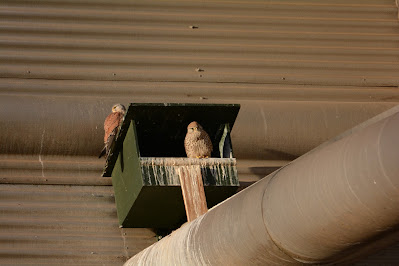Sadly it looks like the Falcon’s advanced year’s – 12+ have put paid to breeding this year, the writing was on the wall in 2022, with 2 infertile eggs laid quite late. Despite numerous displays to each other to date, egg scraping and multiple copulation, age it seems has finally caught up.
It is a shame, as both have totally accepted the new nest box head on, situated in the north east wash tower, it is used daily by the Falcon for an afternoon nap. As above pair bonding is still constant but now approaching mid-April, it is looking very unlikely for egg laying.
It now remains how long will she hang on, non-breeding at Battersea occurred during the years of 2008 to 2012, 5 breeding seasons before the current Falcon ousted her. During those years there was nowhere near the density what we have currently of single immatures and adults. These days, there are so many waiting in the wings in and around London and the outer counties, the challenge on prime sites is constant, not just in the run up to breeding when the urge to pair/breed really kicks in.
Still copulating
Both Grey and Pied Wagtail also breed at the Power Station
Tiercel arriving with Ring Necked Parakeet
This Falcon’s record has been very good as you can see from below.
Considering 2013 was the start of the Construction Phase, the mitigation to keep them breeding on site, by Battersea Power Station Development Company, was quite incredible. The pair accepted the new tower designed for them showing their tenacity, resilience and total bond to the Power Station come what may.
2013 - 2 juveniles - Southwest Wash Tower
2014 - 3 juveniles - Nest Tower
2015 - 4 juveniles - Nest Tower
2016 - 4 juveniles - Nest Tower
2017 - 4 juveniles - Nest Tower
2018 - 1 juvenile - Nest Tower – New Tiercel
2019 - 4 chicks but all were spiked by long staying 2018 juvenile/immature sadly
2020 - 1 juvenile - Nest Tower -
2021 - 3 juveniles - Nest Tower
2022 - 2 eggs but sadly infertile
22 juveniles over the construction phase, at one time boasting 21 Luffer Cranes and everyone one of them used by the Peregrines, quite an incredible species.
.JPG)
.JPG)
.JPG)



.JPG)
.JPG)
.JPG)
.JPG)
.JPG)













